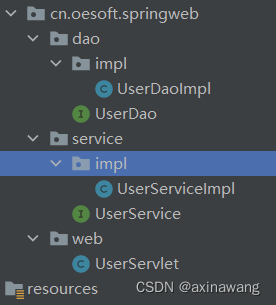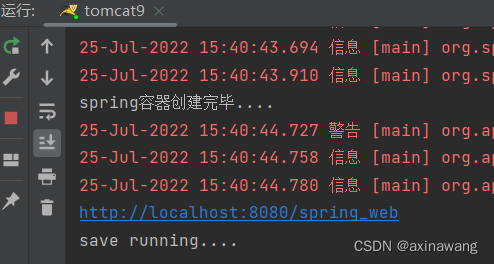先自己开发代码来实现spring与web环境继承,再使用spring提供的工具实现集成。
一、搭建基本三层架构
1、创建javaee项目
2、添加spring核心依赖
<dependency>
<groupId>org.springframework</groupId>
<artifactId>spring-context</artifactId>
<version>5.0.5.RELEASE</version>
</dependency>3、创建userdao、userservice、userservlet
项目结构如下:

具体代码如下:
public class UserDaoImpl implements UserDao {
public void save() {
System.out.println("save running....");
}
}public class UserServiceImpl implements UserService {
private UserDao userDao;
public void setUserDao(UserDao userDao) {
this.userDao = userDao;
}
public void save() {
userDao.save();
}
}
@WebServlet("/userServlet")
public class UserServlet extends HttpServlet {
@Override
protected void doGet(HttpServletRequest req, HttpServletResponse resp) throws ServletException, IOException {
ApplicationContext app = new ClassPathXmlApplicationContext("applicationContext.xml");
UserService userService = app.getBean(UserService.class);
userService.save();
}
}4、创建applicationContext.xml,配置bean
<?xml version="1.0" encoding="UTF-8"?>
<beans xmlns="http://www.springframework.org/schema/beans"
xmlns:xsi="http://www.w3.org/2001/XMLSchema-instance"
xmlns:context="http://www.springframework.org/schema/context"
xsi:schemaLocation="http://www.springframework.org/schema/beans http://www.springframework.org/schema/beans/spring-beans.xsd
http://www.springframework.org/schema/context http://www.springframework.org/schema/context/spring-context.xsd">
<!--配置Dao-->
<bean id="userDao" class="cn.oesoft.springweb.dao.impl.UserDaoImpl"></bean>
<!--配置service-->
<bean id="userService" class="cn.oesoft.springweb.service.impl.UserServiceImpl">
<property name="userDao" ref="userDao"/>
</bean>
</beans>5、测试
http://localhost:8080/spring_web/userServlet
6、源代码spring_web_base
7、结论
应用上下文对象是通过new ClasspathXmlApplicationContext(spring配置文件) 方式获取的,但是每次从容器中获得Bean时都要编写new ClasspathXmlApplicationContext(spring配置文件) ,这样的弊端是配置文件加载多次,应用上下文对象创建多次。
二、自定义ContextLoaderListener
在Web项目中,可以使用ServletContextListener监听Web应用的启动,我们可以在Web应用启动时,就加载Spring的配置文件,创建应用上下文对象ApplicationContext,在将其存储到最大的域servletContext域中,这样就可以在任意位置从域中获得应用上下文ApplicationContext对象了。
1、创建listener包、ContextLoaderListener类
@WebListener
public class ContextLoaderListener implements ServletContextListener {
public void contextInitialized(ServletContextEvent servletContextEvent) {
ServletContext servletContext = servletContextEvent.getServletContext();
ApplicationContext app = new ClassPathXmlApplicationContext("applicationContext.xml");
//将Spring的应用上下文对象存储到ServletContext域中
servletContext.setAttribute("app",app);
System.out.println("spring容器创建完毕....");
}
public void contextDestroyed(ServletContextEvent servletContextEvent) {
}
}2、修改UserServlet,从web应用上下文中获取spring上下文
protected void doGet(HttpServletRequest req, HttpServletResponse resp) throws ServletException, IOException {
ServletContext servletContext = this.getServletContext();
ApplicationContext app = (ApplicationContext) servletContext.getAttribute("app");
UserService userService = app.getBean(UserService.class);
userService.save();
}3、 http://localhost:8080/spring_web/userServlet

三、优化代码
1、把spring配置文件名称放入web.xml
<!--全局初始化参数-->
<context-param>
<param-name>contextConfigLocation</param-name>
<param-value>classpath:applicationContext.xml</param-value>
</context-param>2、修改web应用监听器
web应用初始化后,获取spring配置文件
public void contextInitialized(ServletContextEvent servletContextEvent) {
ServletContext servletContext = servletContextEvent.getServletContext();
//读取web.xml中的全局参数
String contextConfigLocation = servletContext.getInitParameter("contextConfigLocation");
ApplicationContext app = new ClassPathXmlApplicationContext(contextConfigLocation);
//将Spring的应用上下文对象存储到ServletContext域中
servletContext.setAttribute("app",app);
System.out.println("spring容器创建完毕....");
}3、重启tomcat,查看是否能创建spring容器
4、创建工具类来获取spring容器
创建WebApplicationContextUtils.java
public class WebApplicationContextUtils {
public static ApplicationContext getWebApplicationContext(ServletContext servletContext){
return (ApplicationContext) servletContext.getAttribute("app");
}
}5、UserServlet通过工具类获取spring容器
protected void doGet(HttpServletRequest req, HttpServletResponse resp) throws ServletException, IOException {
ServletContext servletContext = this.getServletContext();
ApplicationContext app = WebApplicationContextUtils.getWebApplicationContext(servletContext);
UserService userService = app.getBean(UserService.class);
userService.save();
}6、源代码 spring_web_my_tool
四、Spring提供获取应用上下文的工具
上面的功能不用手动实现,Spring提供了一个监听器ContextLoaderListener就是对上述功能的封装,该监听器内部加载Spring配置文件,创建应用上下文对象,并存储到ServletContext域中,提供了一个客户端工具WebApplicationContextUtils供使用者获得应用上下文对象。
所以我们需要做的只有两件事:
① 在web.xml中配置ContextLoaderListener监听器(导入spring-web坐标)
② 使用WebApplicationContextUtils获得应用上下文对象ApplicationContext
1、导入Spring集成web的坐标
<dependency>
<groupId>org.springframework</groupId>
<artifactId>spring-web</artifactId>
<version>5.0.5.RELEASE</version>
</dependency>2、配置ContextLoaderListener监听器
<!--Spring的监听器-->
<listener>
<listener-class>
org.springframework.web.context.ContextLoaderListener
</listener-class>
</listener>3、通过工具获得应用上下文对象
WebApplicationContext app = WebApplicationContextUtils.getWebApplicationContext(servletContext);
UserService userService = app.getBean(UserService.class);4、测试的时候注释掉自己开发的监听器
5、源代码spring_web
五、 知识要点
Spring集成web环境步骤
① 配置ContextLoaderListener监听器
② 使用WebApplicationContextUtils获得应用上下文























 807
807











 被折叠的 条评论
为什么被折叠?
被折叠的 条评论
为什么被折叠?








